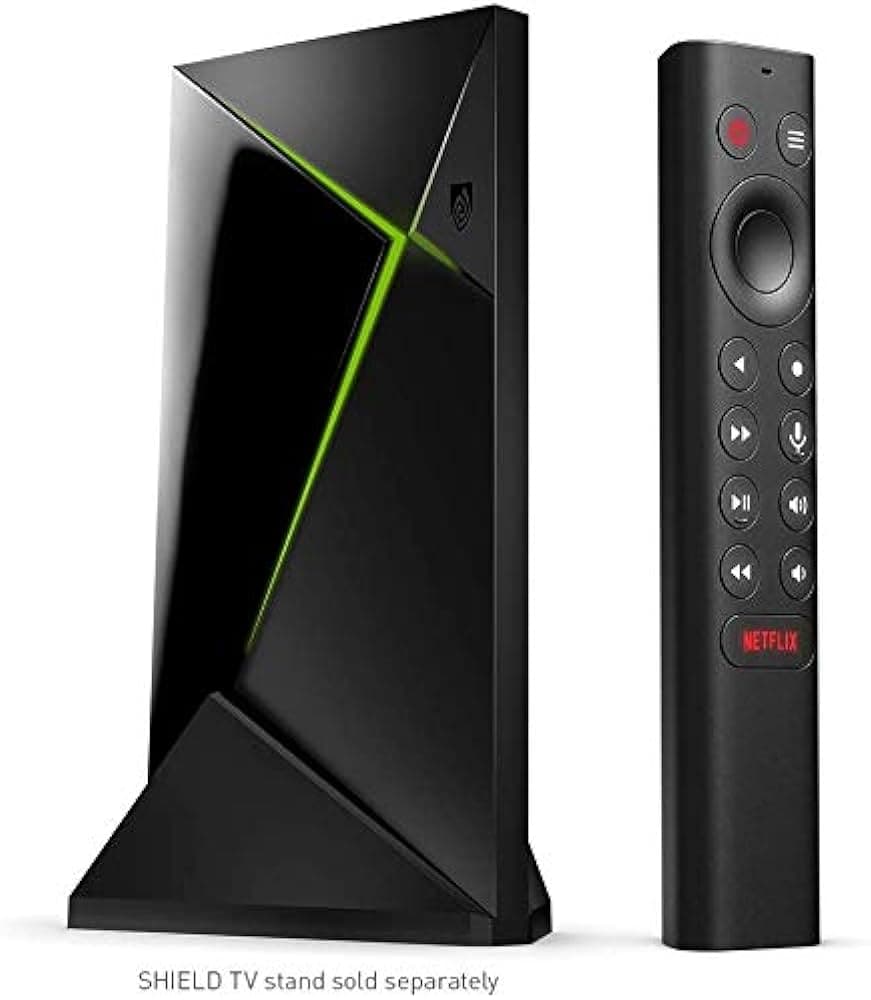The Android TV box market in 2025 is more diverse than ever, offering something for everyone—whether you’re looking for powerful 4K streaming, next-gen gaming, IPTV customization, or just an affordable way to upgrade your TV. With both Google TV and Android TV platforms maturing, new hardware innovations and software improvements are raising the bar for home entertainment.
Below is an updated, more comprehensive guide to the best Android TV boxes you can buy in 2025, featuring trusted options across different price ranges and use cases:

Best Overall Performance: NVIDIA Shield TV Pro
Why It’s Still on Top in 2025:
Despite being several years old, the Shield TV Pro remains unmatched in performance and versatility thanks to its Tegra X1+ processor, AI-powered 4K upscaling, Dolby Vision & Atmos, GeForce NOW support, and broad codec compatibility. It’s also one of the few Android TV boxes that handles Plex servers, emulation, and high-end streaming with ease.
- RAM/Storage: 3GB RAM / 16GB storage
- Ports: 2x USB 3.0, Ethernet
- Ideal For: Power users, gamers, Plex, sideloaders
- Downsides: Pricey, no recent hardware update
Best Value for Money: Onn. Google TV 4K Pro (Walmart Exclusive)
Why It’s Great:
Walmart surprised the industry by releasing a $49 Android TV box that punches well above its weight. It’s fast, feature-rich, and comes with 3GB of RAM, 32GB of storage, hands-free voice control, and support for Dolby Vision/Atmos. It’s also fully certified for HD/4K streaming on major apps.
- OS: Google TV
- Standout Feature: Magic Star button for fast channel access
- Ideal For: Streaming enthusiasts on a budget
- Bonus: No ads on the home screen, unlike Fire TV
Best for Gaming & IPTV: Formuler Z11 Pro Max
Why It’s Great:
Designed specifically for IPTV, the Formuler Z11 Pro Max is packed with 4GB RAM, 32GB storage, and an advanced MyTVOnline 3 interface that makes watching live TV a breeze. It’s also great for emulation and supports a wide variety of media formats.
- Drawback: No Netflix HD certification
- Ideal For: IPTV, emulation, side-loaded apps
- Notable Feature: Multi-view and PVR recording
Best Mainstream Streaming Device: Chromecast with Google TV (4K)
Why It’s Great:
Google’s compact streamer delivers snappy performance with 4K HDR support, Dolby Vision, Dolby Atmos, and a smooth interface. While newer options exist, it’s still a solid plug-and-play solution for most households.
- Downside: 8GB storage fills up fast
- Ideal For: Plug-and-play streaming
- Remote: Voice control with Google Assistant
Best Newcomer: Google TV Streamer (4K, 2025 Edition)
What’s New in 2025:
Google’s latest streamer replaces the Chromecast Ultra and adds AI-driven content suggestions (via Gemini AI), 32GB of internal storage, and improved smart home integration. It also supports over 150 free live TV channels via the new “Free TV” remote button.
- Ideal For: Smart home integration, content discovery
- AI Features: Personalized recommendations based on habits
Best for Emulation & Customization: X96 Max+
Why It’s Popular:
For DIY users and emulation fans, the X96 Max+ offers great flexibility. It runs on an S905X3 chip, supports EmuELEC and LibreELEC, and includes a microSD slot and USB ports. Not officially certified for Netflix 4K, but fantastic for Kodi, retro games, and sideloading.
- Specs: 4GB RAM / up to 64GB ROM
- Downside: Mixed app compatibility
- Best For: Tinkerers and hobbyists
Best Entry-Level Streamer: Onn. 4K Google TV (Standard Model)
Why It’s Worth a Look:
At just $19.88, Walmart’s basic Onn. 4K box gives you access to Google TV, solid 4K playback, and decent performance for basic streaming. It’s the cheapest certified 4K streamer on the market.
- Specs: 2GB RAM / 8GB storage
- Drawbacks: Lower RAM, can lag with multitasking
- Best For: Secondary TVs, guest rooms
Most Anticipated: Onn. 4K Plus (Coming Mid-2025)
What to Expect:
Walmart is expanding its lineup with this mid-tier model aimed at those who want more than the standard box but don’t need the Pro. It features 2GB RAM, 16GB storage, Dolby support, and likely the same clean, ad-free Google TV interface.
Honorable Mentions & Alternatives
| Device | OS | Key Strengths | Price |
|---|---|---|---|
| Xiaomi TV Box S (3rd Gen) | Google TV | Dolby Vision, HDR10+, good for casual users | ~$70 |
| Amazon Fire TV Cube (3rd Gen) | Fire TV OS | Fast, hands-free Alexa, Ethernet & IR blaster | ~$139 |
| Roku Streaming Stick 4K+ | Roku OS | Simple UI, wide app support, Dolby Vision | ~$49 |
⚠️ A Note on Generic Android Boxes
You’ll often see boxes on Amazon labeled “Android TV Box 2025” with 4GB+ RAM and high storage claims. While they may look appealing, many are uncertified, don’t support HD streaming for Netflix or Prime Video, and some may even come with pre-installed malware. Stick to certified models from brands like Google, NVIDIA, Walmart (Onn), Xiaomi, and Formuler for the best experience.

Final Thoughts
Whether you’re chasing top-tier gaming, seeking value, or just need a simple way to watch Netflix in 4K, there’s an Android TV box for you in 2025. As more brands embrace Google TV and AI integration becomes more widespread, expect this space to continue evolving—especially with the rise of free TV channels, better storage, and smarter content curation.
Key Takeaways
- NVIDIA Shield TV Pro continues to lead the market with premium performance and gaming capabilities, while new budget options provide strong alternatives.
- Look for devices with at least 4GB RAM, strong WiFi connectivity, and current Android TV versions for the best streaming experience.
- Software support, interface responsiveness, and HDR compatibility are critical factors that often matter more than raw specifications when choosing an Android TV box.
Key Features of Top Android TV Boxes
Our favorite Android TV box of 2025 is the NVIDIA Shield TV Pro, which is best known for its premium performance and 4K HDR streaming. Budget-friendly alternatives like the Xiaomi TV Box S (2nd Gen) and the KM2 Plus Deluxe offer great functionality at lower prices.
Important factors to consider when choosing an Android TV box include processing power, RAM, storage capacity, and software support. New models feature improved WiFi connectivity (WiFi 6), increased storage (up to 64GB), and powerful processors that handle 4K and 8K content effectively.
When shopping for an Android TV box in 2025, several key features differentiate the premium models from basic options. The best devices balance performance, viewing quality, connectivity, and software integration to deliver a complete entertainment experience.
Performance and Storage Capabilities
The 2025 Android TV box market is dominated by devices with powerful processors and ample memory. The NVIDIA Shield TV Pro continues to lead with its NVIDIA Tegra X1+ processor, offering smooth performance for both streaming and gaming applications. Most premium boxes now include at least 4GB of RAM, with high-end models offering 8GB for seamless multitasking.
Storage has become increasingly important as apps grow in size. Entry-level boxes typically provide 32GB of internal storage, while premium options offer 64GB or more. Nearly all models include USB ports for connecting external drives, making storage expansion simple and affordable.
App loading times have decreased significantly compared to older models. The best Android TV boxes can now launch even complex apps like Kodi in under 3 seconds, ensuring users spend less time waiting and more time enjoying content.
Enhanced Viewing Experience
Video quality capabilities represent a critical differentiator between Android TV boxes. All premium 2025 models support 4K resolution, but the best options go further with advanced HDR support including Dolby Vision, HDR10, and HLG formats. This expanded dynamic range creates more lifelike images with deeper blacks and brighter highlights.
The NVIDIA Shield stands out with its AI upscaling technology that improves the appearance of lower-resolution content on 4K displays. Most top boxes now support 60fps playback for smoother motion in sports and action scenes.
Audio hasn’t been neglected either. Premium Android TV boxes feature Dolby Atmos and DTS pass-through, delivering immersive surround sound when connected to compatible audio systems. This creates a true cinema-like experience in home theaters.
Connectivity and Control Options
Modern Android TV boxes offer robust connectivity options. Ethernet ports provide the most stable connection for 4K streaming, with many premium models supporting Gigabit speeds. Dual-band WiFi 6 is now standard, offering faster wireless performance than previous generations.
HDMI 2.1 support has become common, allowing for higher refresh rates and improved audio return channel (eARC) functionality. Bluetooth 5.0 connectivity enables pairing with headphones, game controllers, and keyboards without dongles.
Voice control has evolved significantly in recent models. Most Android TV boxes integrate Google Assistant for hands-free operation, allowing users to search for content, control playback, and even manage smart home devices. Remote controls have been simplified while gaining functionality, with many now featuring dedicated buttons for popular streaming services.
Platform and Ecosystem Integration
The software experience divides primarily between Google TV and custom Android TV interfaces. Google TV offers a more curated experience with personalized recommendations across services, while traditional Android TV provides a more app-focused approach.
Access to the Google Play Store ensures users can install thousands of apps and games. The best boxes fully support popular streaming platforms like Netflix, Amazon Prime, Disney+, and HBO Max at their highest quality levels.
Kodi compatibility remains important for many users. Premium boxes handle Kodi add-ons smoothly, with enough processing power for advanced skins and video processing. Gaming capabilities vary widely, with NVIDIA’s Shield offering the most robust game streaming options through GeForce NOW.
Smart home integration has improved across all models, with most supporting Matter and Thread protocols for simplified device control across ecosystems.
Comparing Popular Android TV Boxes
When shopping for Android TV boxes, several factors can make a big difference in your viewing experience. The market offers a range of options from budget-friendly to premium models, each with different features and capabilities.
Budget-Friendly Versus Premium Models
The price gap between entry-level and high-end Android TV boxes is significant. Budget options like the Roku Express 4K typically range from $30-$50, offering basic 4K streaming and decent performance for casual users.
Mid-range options include the Amazon Fire TV Stick 4K Max at around $55, which provides enhanced processing power and improved Wi-Fi connectivity compared to budget models.
For those seeking premium performance, the NVIDIA Shield stands out at approximately $150-$200. The Shield offers powerful gaming capabilities, AI-enhanced upscaling, and the smoothest interface experience available.
Premium models generally provide faster processors, more RAM (4GB+ vs 1-2GB), additional storage, and better build quality. However, budget models now offer many core features that used to be premium-only, like 4K support and voice control.
Compatibility With Streaming Services
NVIDIA Shield devices offer the most comprehensive app support, including Netflix, Prime Video, Hulu, Disney+, and HBO Max at their highest quality settings with proper HDR and audio codec support.
Budget boxes sometimes struggle with certain streaming apps. Some less expensive models can’t play Netflix in full HD or 4K due to lacking proper certification.
Many Android TV boxes also support local media playback. Premium options like Zidoo and high-end NVIDIA models offer enhanced audio passthrough capabilities for home theater enthusiasts.
App stability varies significantly across devices. Higher-end boxes generally provide more consistent streaming experiences with fewer crashes or buffering issues.
User-Friendly Experience
The interface plays a crucial role in daily usability. Google TV and Android TV interfaces offer clean, intuitive navigation that most users can quickly master.
Remote control quality matters more than many buyers realize. NVIDIA Shield and Amazon Fire devices include voice-enabled remotes that simplify searching and navigation.
Setup complexity varies between models. Budget-friendly options like the Homatics Box Q typically offer plug-and-play simplicity, while premium boxes like the Ugoos AM6 Plus may require more configuration for advanced features.
System updates represent another key difference. Premium models generally receive longer support periods with more frequent security and feature updates, ensuring compatibility with newer apps and services.
Frequently Asked Questions
Android TV boxes continue to evolve with new features and capabilities. These devices offer consumers various options for streaming, gaming, and enhancing their home entertainment systems.
What are the top features to consider when choosing the best Android TV box in 2025?
When shopping for an Android TV box in 2025, RAM and storage should be top priorities. Most quality boxes now offer at least 4GB RAM and 32GB storage, with premium models featuring 8GB RAM and 64GB or more storage.
Processing power remains crucial for smooth performance. Look for boxes with newer processors like the Amlogic S905X4 or better to ensure good performance for streaming and gaming.
Connectivity options matter too. The best Android TV boxes now include WiFi 6, Bluetooth 5.0, Gigabit Ethernet, and multiple USB ports for external devices. HDMI 2.1 support is essential for those with newer 4K or 8K televisions.
How does the performance of the latest Nvidia Shield compare to other Android TV boxes on the market?
The Nvidia Shield continues to lead the Android TV box market in 2025. Its custom Tegra processor still outperforms most competitors in gaming and AI-enhanced video upscaling.
The Shield offers exceptionally smooth performance with virtually no lag when navigating menus or switching between apps. This performance edge is particularly noticeable when running demanding applications or games.
While priced higher than competitors, the Shield justifies its cost through superior build quality, regular software updates, and gaming capabilities that other boxes simply can’t match.
Can you list the most recommended Android TV boxes for gaming and their distinctive features?
The Nvidia Shield Pro remains the top gaming Android TV box with its powerful GPU, GeForce Now compatibility, and ability to stream PC games from your computer. It also features exclusive Android game ports.
The Onn 4K Pro has emerged as a budget-friendly gaming option. It offers decent performance for casual gaming and comes with a game-friendly remote controller.
For mid-range options, the Mecool KM2 Plus provides good gaming performance with its Mali-G52 GPU and optimized game mode that allocates more system resources to games when needed.
What are the differences between the latest Android TV boxes and smart TV boxes?
Android TV boxes run Google’s official Android TV operating system with access to the Google Play Store. This ensures compatibility with major streaming services and regular security updates.
Smart TV boxes might run modified versions of Android that look similar but lack Google certification. These boxes often have more customization options but may struggle with popular apps like Netflix or Disney+.
Interface design also differs significantly. Android TV uses a row-based interface optimized for remote control navigation, while generic smart TV boxes might use interfaces better suited for touchscreens.
Which Android TV boxes offer the best support for IPTV services?
The Formuler GTV offers specialized IPTV support with its proprietary MyTVOnline 2 app. This provides an EPG interface, recording capabilities, and optimized streaming performance for IPTV services.
Beelink boxes have gained popularity for IPTV use due to their stable Ethernet connections and powerful processors that handle heavy IPTV apps smoothly. They also support various IPTV formats.
For budget options, the X96 Max+ provides good IPTV performance at a lower price point. It supports most IPTV applications and offers decent performance for standard and HD streams.
What are the latest advancements in Android TV OS that are relevant for TV boxes?
The latest Android TV OS now features improved content discovery with AI-powered recommendations that learn from viewing habits. This helps users find relevant content across multiple streaming services.
Voice control capabilities have been enhanced significantly. The system now supports more natural language commands and can control smart home devices directly through the TV box.
Privacy features have also improved with granular app permissions and transparency about data collection. Users can now better control what information their TV box shares with Google and app developers.
If you want to have contact with us ~ [email protected]






